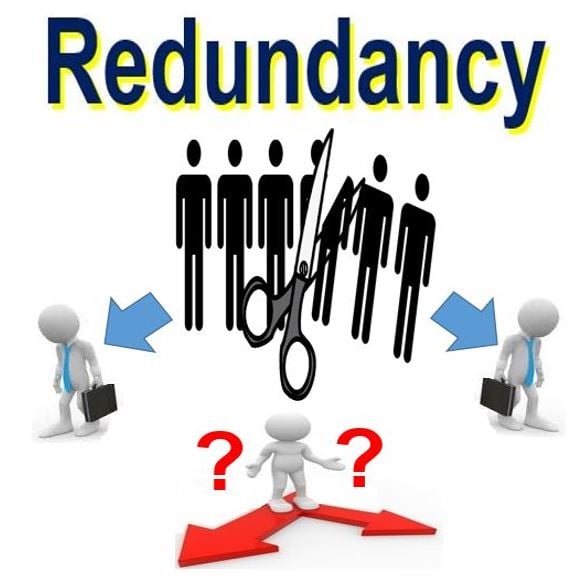If a Company Goes Bust Who Pays Redundancy? Lawful Insights for UK Employees
If a Company Goes Bust Who Pays Redundancy? Lawful Insights for UK Employees
Blog Article
Discovering the Operational Dynamics of Company Redundancy and Its Long-Term Sustainability

Redundancy Strategies for Organization Continuity
In order to guarantee nonstop operations, services must execute reliable redundancy techniques for service continuity. Redundancy in this context describes the replication of crucial parts or functions within a system to reduce the influence of potential failures. By including redundancy strategies, companies can boost their resilience against interruptions brought on by various variables such as all-natural disasters, devices failures, or cyber-attacks.
One common redundancy method is the application of back-up systems and information storage space solutions. This involves producing matches of crucial data and systems that can be activated in case of a primary system failing. In addition, companies can develop repetitive interaction networks and source of power to preserve connectivity and operations during unforeseen events.
Furthermore, cross-training workers to carry out multiple functions within the company can work as an important redundancy technique. This ensures that essential tasks can still be accomplished also if key workers are not available because of disease or other reasons. Generally, effective redundancy strategies are essential for organizations to copyright functional continuity and minimize the influence of prospective interruptions.
Influence of Redundancy on Organizational Strength
Offered the important duty redundancy approaches play in guaranteeing company continuity, discovering the effect of redundancy on business strength ends up being crucial for comprehending the holistic functional dynamics of a company. Business resilience describes an entity's capacity to adjust to interruptions, recover from obstacles, and transform when necessary while maintaining core functions. Redundancy, when purposefully executed, can substantially contribute to enhancing a company's durability despite unforeseen challenges. By having back-up systems, employees, or processes in position, firms can better withstand shocks and continue procedures with marginal disruption.
In addition, redundancy can foster innovation and creative thinking within a company as workers really feel encouraged to take computed dangers, knowing that there is a safety and security net to sustain them visit site in situation of failure. Generally, the impact of redundancy on organizational strength is extensive, shaping read here the lasting sustainability and success of a business.
Balancing Performance and Versatility in Redundancy
Attaining a harmonious balance in between functional performance and flexible adaptability is a pivotal difficulty in the critical deployment of redundancy within companies. Also much adaptability without a strong functional foundation can result in ineffectiveness and inconsistency.
To stabilize performance and adaptability in redundancy preparation, organizations have to meticulously evaluate their functional requirements, market characteristics, and strategic objectives. Eventually, discovering the ideal stability in between efficiency and adaptability is critical for developing a durable and sustainable company in the face of uncertainty.
Long-Term Sustainability Through Redundancy Planning
To ensure enduring viability and stability, organizations need to tactically straighten their redundancy preparation with lasting sustainability objectives, thus balancing functional effectiveness with flexible flexibility. Business need to watch redundancy not as a responsive remedy to instant troubles however as an aggressive technique for long-lasting success.

Aggressive Actions for Lasting Company Operations
Exactly how can companies proactively enhance their functional sustainability for long-term success? Carrying out proactive actions is crucial for business aiming to make sure lasting procedures.
Additionally, fostering a culture of continual improvement and learning within the company can boost adaptability to altering market problems and client demands. Urging employee involvement in decision-making procedures and supplying chances for professional development can increase morale, efficiency, and general performance. Developing clear objectives, checking crucial efficiency indications, and regularly reviewing progression are important elements of positive sustainability administration.
Collaborating with distributors, clients, and various other stakeholders to advertise sustainable techniques throughout the supply chain can create a surge impact of favorable effect - redundancy pay if company goes bust. By taking proactive actions towards functional sustainability, business can develop resilience, drive advancement, and secure their long-lasting success in an ever-evolving company landscape
Conclusion

In the realm of business administration, the critical release of business redundancy stands as a pivotal yet complex practice that demands a delicate equilibrium in between operational performance and long-lasting viability. By studying the functional characteristics that underpin business redundancy and evaluating its wider implications for organizational strength and versatility, a nuanced understanding of just how redundancy methods can form the future trajectory of a business starts to unfold.Provided the crucial function redundancy strategies play in making certain business continuity, exploring the impact of redundancy on organizational resilience comes to be crucial for comprehending the holistic operational dynamics of a company. Generally, the influence of redundancy on organizational durability is extensive, forming the long-term sustainability and success of a business.
In verdict, understanding the operational dynamics of business redundancy is important for ensuring long-term sustainability.
Report this page